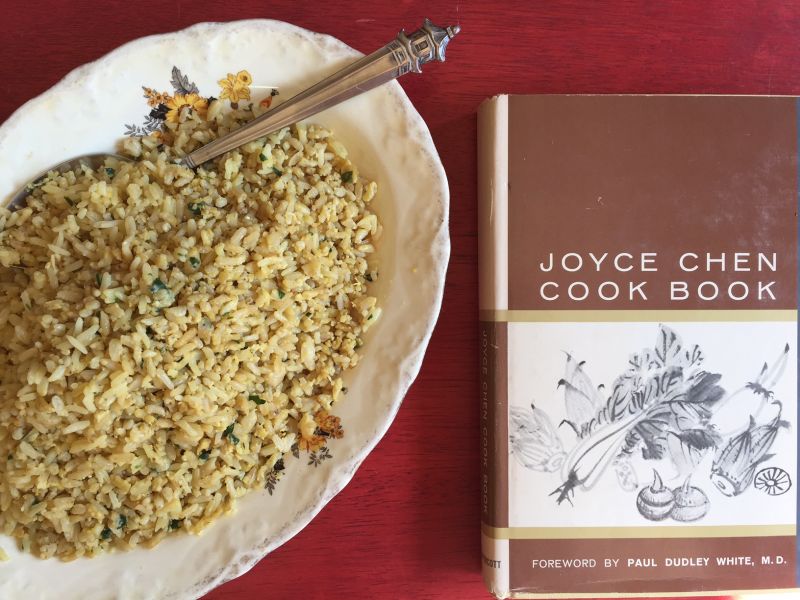
It’s true what they say – everything old is new again. Right now, Joyce Chen, the first Asian person to have a television cooking show in America, is having a moment. It’s a good, positive moment, initiated by a compelling profile of her written by Mayukh Sen at Food52. He did a lot of research to point out how despite her being Julia Child’s contemporary (they shared initials as well as the same television show set), she didn’t enjoy the same level of success as Child. There are many reasons why, including the fact that Chen struggled with speaking English and that food television favors European concepts.
Mayukh contacted me during his writing process asking if I had Chen’s cookbook. I had to admit that I didn’t having skipped over her because she seemed overly Americanized in her approach. Alas, I wasn’t old enough to appreciate her work. After reading Mayukh’s article, I tracked down a copy of her 1962 cookbook.
The Joyce Chen Cook Book arrived yesterday and I was charmed and stunned at how progressive Chen was. She was from a well-off Beijing family and came to America in 1949 via Shanghai. She doesn’t go into detail but that was a tumultuous time in Chinese history. Mao Zedong proclaimed his power and a new communist country on October 1, 1949. Chen refers to her native country as “red China” in the cookbook. If you’re unfamiliar with that term, it conveys animosity.
She was smart and earnest in wanting to present good Chinese flavors via doable recipes. The Joyce Chen Cook Book had only one (1) full color photo, reflecting how books were made in the 60s. The other photo was her author photos on the book jacket.
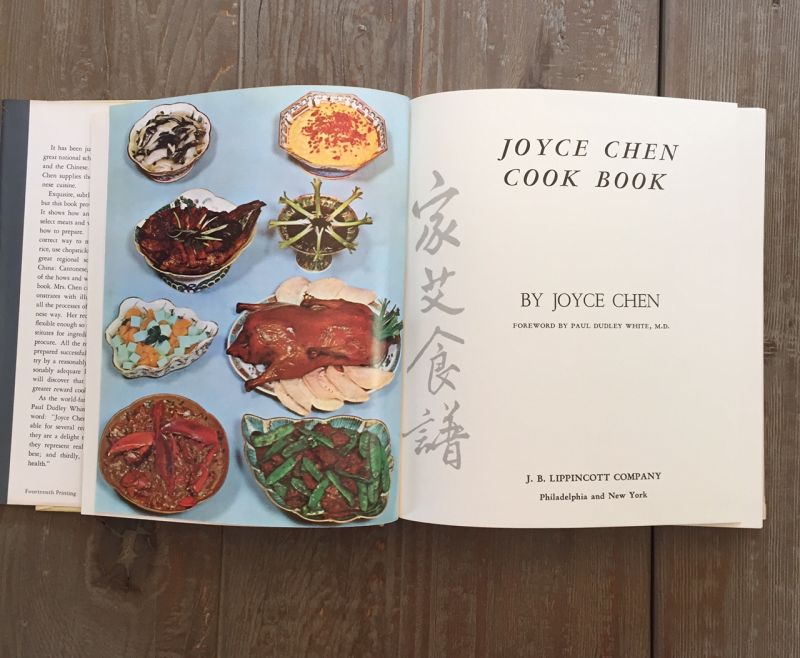
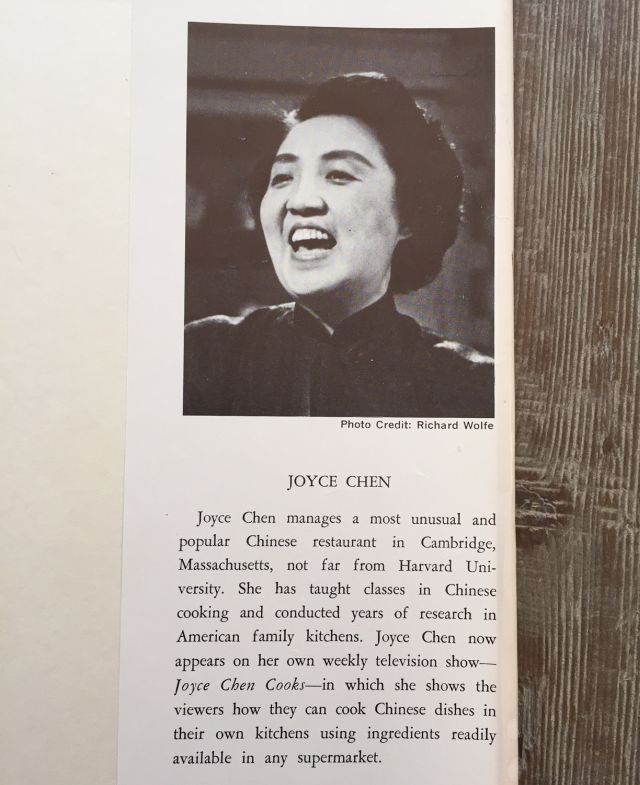
Otherwise, it was text and sweet hand done illustrations. The Joyce Chen Cook Book is full of gems. For example, the ingredient section opener below. Before the internet, Chen was into connecting and building community. She offered her address, in case cooks have questions. And if you have a beef about a recipe, you better have read it carefully and worked through as it was written. At the back of the book are the cheat sheets for grocery shopping that she referred to.
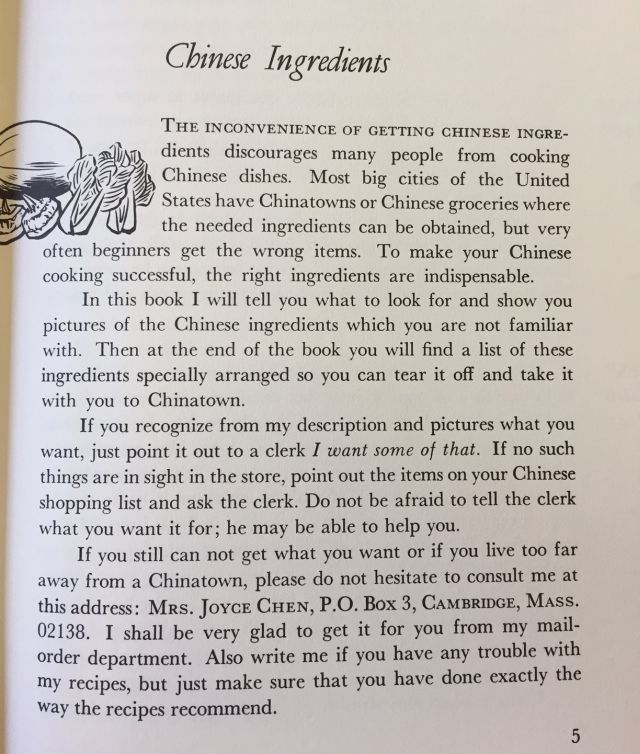
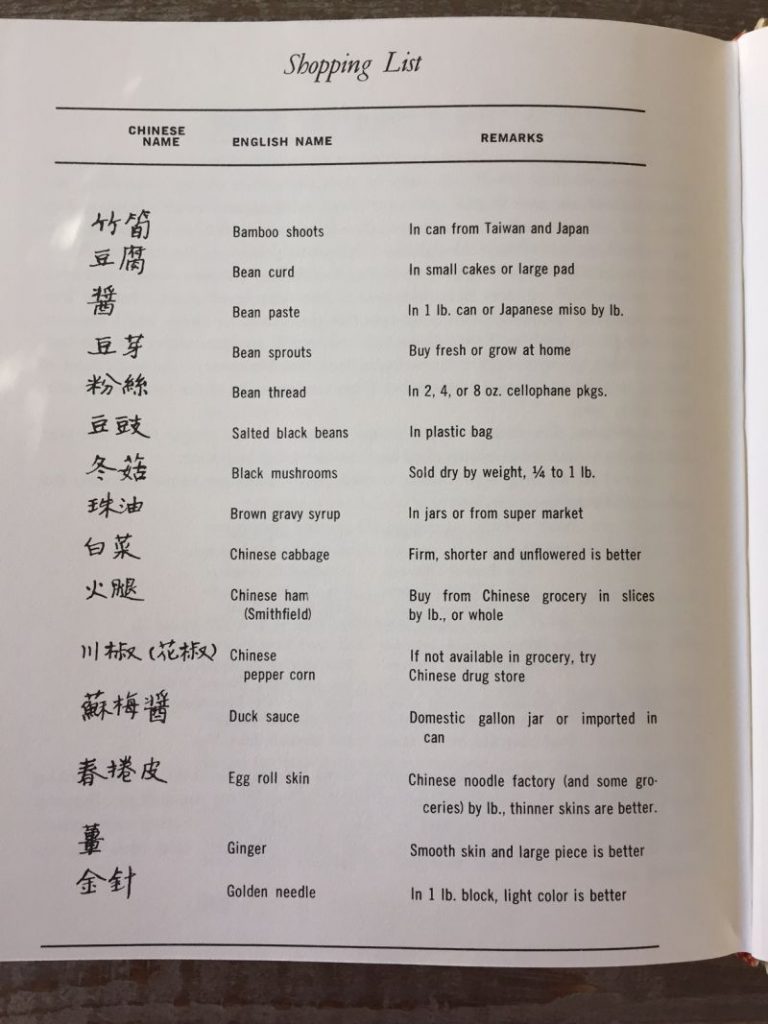
She knew what Americans wanted to master in the Chinese repertoire – fried rice, but she was also a teacher at heart. All of that explained her tone in this chapter opener:
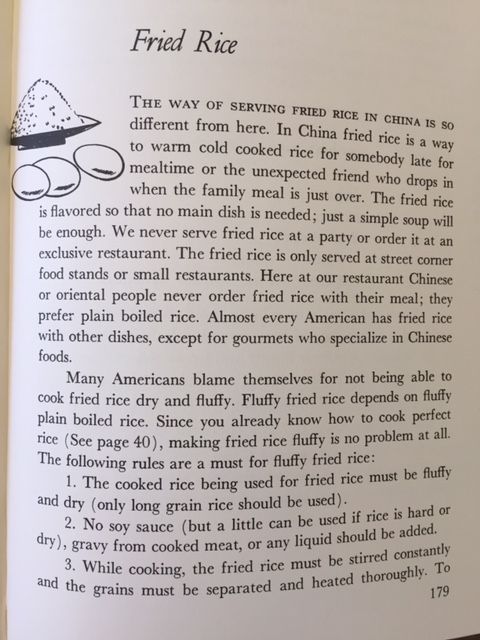
Chen was so honest and practical. I was charmed enough to test drive her egg fried rice recipe. How would it stand up to 55 years of change?
I made the rice five times, preparing half batches using different seasonings. MSG is used throughout the Joyce Chen Cook Book (she suggests buying it in 1-pound bags at a Chinese market so it’s cheaper) as well as a lot of salt. I don’t have an issue with MSG but the amount of salt was overwhelming so I interpreted it as coarse Kosher salt and halved it to get an equivalent in fine sea salt.
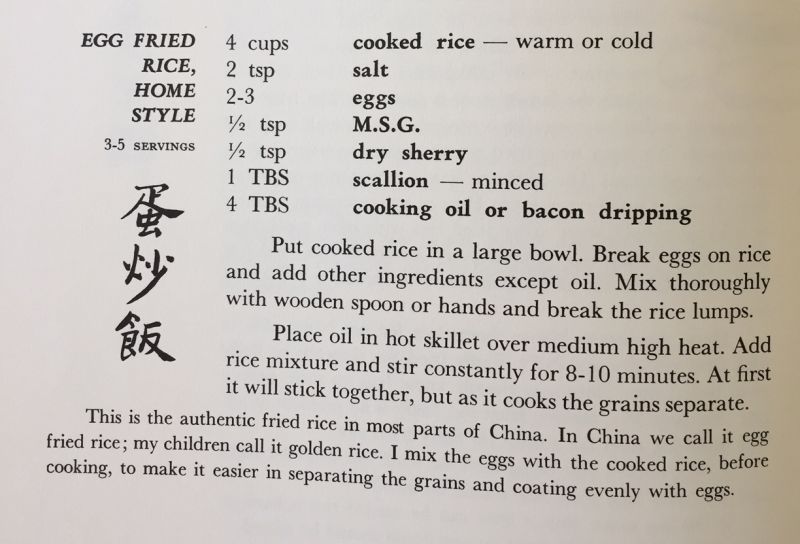
Umami wasn’t a thing in 1962 but she used MSG as an umami flavor builder. To that end, I used MSG but also tried her recipe with modern MSG-free flavor enhancers: Po Lo Ku mushroom seasoning powder sold at Asian markets and elsewhere, Takii umami powder (a slightly less salty version of the Po Lo Ku seasoning powder), and nutritional yeast powder (“Nooch”) sold at health food stores and even Trader Joe’s (there are Nooch flakes too but you have to double the quantity used).
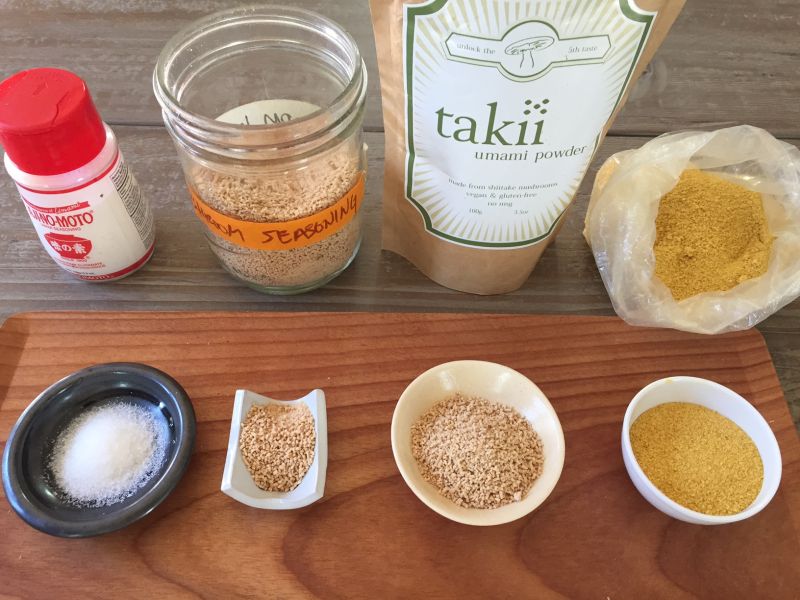
What did I discover? With minor tweaks, Chen’s original recipe stood the test of time. The MSG version was good. It smelled and tasted like an elegant fried rice – even though she described it as a humble dish. Her recipe worked just as she described: the rice and egg mixture stuck together at first but then it separated into individual grains. Keep on stirring!!!
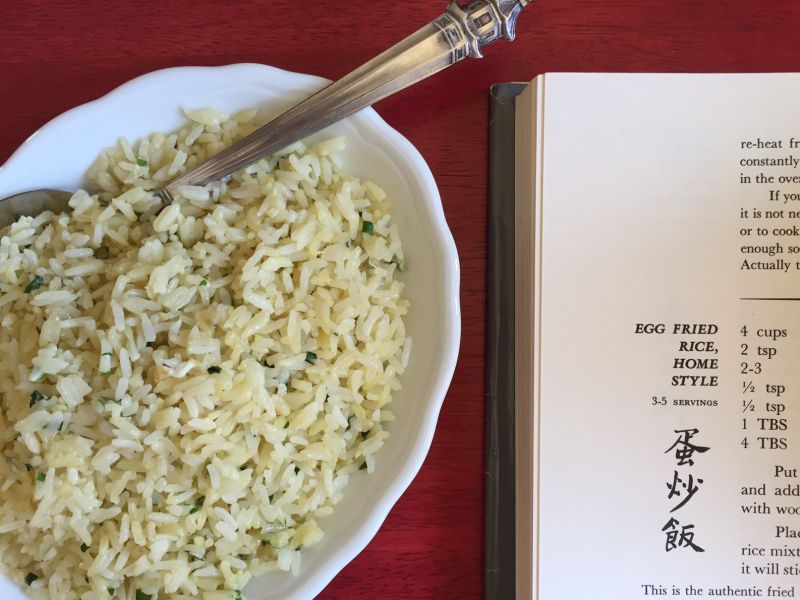
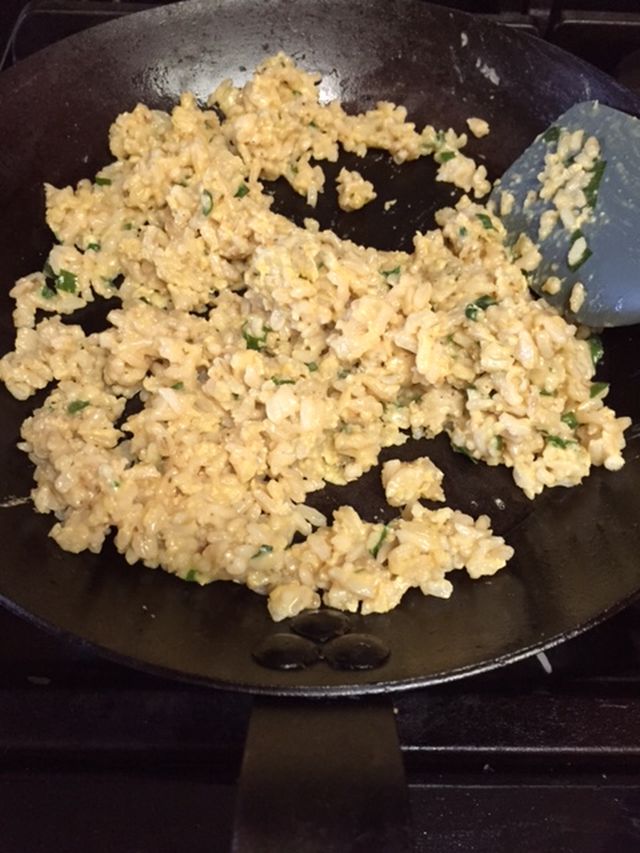
How about the MSG-less flavor enhancers? The mushroom seasoning was good as an MSG substitute. The Nooch version was richly yellow like egg yolk but it needed a boost from Bragg Liquid Aminos (you can use Maggi Seasoning or soy sauce). Note that I mention MSG, mushroom seasoning and nutritional yeast in The Pho Cookbook; they are not out there ingredients.
Because I've never had good luck with frying warm rice, I cooled my rice to room temperature on a baking sheet to ensure that the grains would separate. I made jasmine rice and followed my perfect rice recipe here.
At first, I mixed the ingredients like she suggested but it seemed ineffective. Subsequently, I beat the egg and seasonings then added the rice. The grains got coated much easier.
I used a medium carbon steel skillet to make sure the cooking surface would get plenty hot. My cooking time for half a batch was about 4 minutes so for a full batch of the original recipe using a larger (11 to 12-inch skillet, it would take 8 to 10 minutes as she specifies.
What interested me was the amount of eggs: 2 or 3? I halved the recipe so at first I used one egg. Then I increased the egg and the rice at first looked like risotto in the pan (above) but then it cooked up into bigger grains because there was more egg to coat each one. It was good either way. There’s a lot of leeway in what is basically, a super easy, delicious fried rice. You can whip it up with white or brown jasmine rice. When a recipe is well written, it's a classic.
P.S... Pho Cookbook Event Announcement! In a couple of weeks, I'll be in Seattle for a very special event at the new Ba Bar location at University Village. Join me, chef/restaurateur Eric Banh and the Saigon Siblings restaurant team. Expect raucous conversation, tastings, and a book signing. More details and ticket info are here.
Golden Egg Fried Rice
Yield 1 to 2 servings
Ingredients
- 1 large or jumbo egg
- 1 scant tablespoon chopped green onion
- ¼ teaspoon MSG, ½ teaspoon mushroom seasoning, or 2 teaspoons nutritional yeast powder (Nooch)
- ½ teaspoon fine sea salt
- ¼ teaspoon dry sherry or Shaoxing rice wine, or ½ teaspoon Bragg Liquid Aminos, if you’re using Nooch
- Brimming 2 cups cooked long-rain rice, at room temperature
- 1 to 1 ½ tablespoon neutral oil or bacon dripping
Instructions
- In a bowl and with a fork, beat together the egg, green onion, MSG (or other flavor enhancer), salt, and sherry (or Bragg). Add the rice and stir vigorously to combine well.
- Heat a medium (10-inch) well-seasoned carbon steel wok or skillet, or nonstick pan over medium-high heat. Add the oil (or bacon dripping). When shimmering, dump in the rice. Stir and fold constantly for 3 to 4 minutes to cook evenly and separate the grains. The rice will be sticky and clump together at first but eventually separate. When the grains have separated and are pale yellow, you’re done! Serve on a plate to share or in individual bowls.
Notes
When doubling this recipe, use a large (12-inch skillet) to cook and you'll need to keep stirring for 8 to 10 minutes total.
Adapted from Joyce Chen Cook Book (Lippincott, 1962)
Courses Lunch, Dinner
Cuisine Chinese













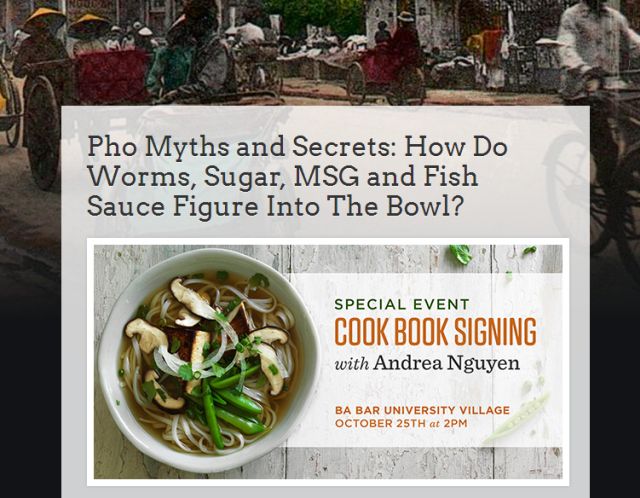
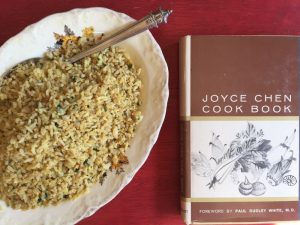



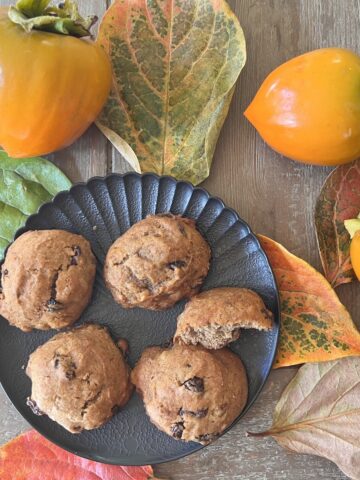
Nishant says
Aah, what an inspiring post! Only a small correction - his name is Mayukh, not Mayuhk.
Andrea Nguyen says
Darn it. Thanks. Made the edit.
Gillie says
I used to watch Yan Can Cook every Saturday afternoon, wishing I had access to many of the ingredients. I've never heard of Joyce Chen, but will look for her book now, her fried rice sounds amazing!
Thank you for trying her recipe out so many times to see how to modernize it for todays palate.
Andrea Nguyen says
I'm with you, Gillie. It's never too late to learn something new.
Jean B. says
I had to run to my bookcase because I thought that my use of a bit of bead molasses in (Chinese) fried rice emanated from The Joyce Chen Cook Book. I see that this stems from her recipe for Cantonese fried rice, which is on the next page. It took a while for me to figure out that this was the syrup in that recipe (or it was suggested to me as a substitute... I don't remember).
It is interesting for me to read about your discovery of Joyce Chen so many years after her cookbook came out, but then I come from Joyce Chen territory. We used to eat at her original restaurant when I was a child, and I often frequented her other restaurants until they closed, She also had a huge Asian grocery store in one of Boston's western suburbs, followed by a much-smaller one after that one closed. (Actually the latter was probably operated by one of her children.)
Joyce Chen's original restaurant was so different from the other "Chinese" restaurants in the area. And her cookbook was the first one that went beyond those which I generally regard as being totally archaic. (I will add that collect cookbooks, and I am especially interested in Asian cookery. )
Andrea Nguyen says
People who lived in the Northeast definitely knew about Joyce Chen. A handful of people have said that they they frequented her restaurants. Alas, I didn't arrive to the U.S. till 1975 but it's never too late to check out a classic.
Thank you for sharing your J.C. experience. She had relevance decades later!
Tiffany Cheng says
Cantonese Egg fried Rice is my most favourite fried rice alongside with Yangzhou Fried Rice.
Trang says
Hi Andrea, I love your blog. Would you recommend buying Joyce Chen's cookbook?
Andrea Nguyen says
It's a little outdated so you have to interpret some of the recipes. If you cook well and know your way around the Asian pantry, I'd get the book. It's a good cooking adventure.
Joyce Mowry says
I would definitely agree. I love her hot and sour soup recipe as well as her moo shi pork. I am actually making her choo choo train rice tomorrow
Andrea Nguyen says
Love that you're a Joyce Chen fan!!!! I'm going to check out the choo choo train rice recipe. Thank you for tips.